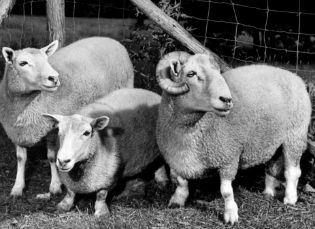Otter-sheep Hybrids?
Hybrids out of History
EUGENE M. MCCARTHY, PHD GENETICS, ΦΒΚ
|
I am obliged to report that which is reported, but not to believe it.
—Herodotus, The History, VII, 152
|

Note: This extremely disparate cross has been alleged in old reports, but the actual occurrence of otter-sheep hybrids has never been established.
The Ancon breed of sheep (see photo right) differs markedly from ordinary sheep. These sheep have long bodies, extremely short legs and crooked forelegs. They also carry their heads down, in line with the spine, instead of up like normal sheep, a condition known as “down head.” Substantially smaller than ordinary sheep, they were originally known as the Otter breed because it was thought at the time the first such sheep was born that it had been produced by a mating between an otter and a ewe. Thus, a paper published in the Philosophical Transactions of the Royal Society (Humphreys 1813) and describing the new breed of sheep mentions the possibility that the founding individual might have been derived from such a cross. The relevant passage in the article (Humphreys 1813, p. 88), reads as follows: “Seth Wight, who possessed a small farm on the banks of Charles River, in the town of Dover and State of Massachusetts, about sixteen miles distant from Boston, kept a little flock
composed of fifteen ewes and one ram. In the year 1791, one of the ewes produced a lamb of singular appearance. By the advice of some of his neighbours, he killed his former ram, and reserved the young one for breeding. The first season, two lambs only were yeaned in his likeness. In the following years, a number more, distinguished by the same peculiarities. Hence proceeded a strongly marked variety in this species of animals, before unknown in the world. It has been called by the name of the Otter breed.
This name was given from a real or imaginary resemblance to that animal, in the shortness of the legs and length of the back; by some supposed to have been caused by an unnatural intercourse; by others, perhaps as fancifully, from fright during gestation. It is only certain that otters were then sometimes seen on the banks of this river. They have since disappeared.
by Gene McCarthy
Ought an otter mount a sheep,
While that sheep lies fast asleep?
Ought an otter make a son,
With a ewe his brother’d shun?
Ought an otter’s daughter bleat?
Or have hooves instead of feet?
Mother Nature might say no,
But who knows what’s apropos?
At the time, belief in hybrids between very disparate sorts of animals, even ones between humans and non-human animals, was far more prevalent than it is today. For example, many early nineteenth century veterinarians believed that a horse could cross with a cow. In 1826, a physician published a detailed description of what he thought was a cow-human hybrid. Most modern biologists would, however, scoff at such a notion, and the Ancon breed is now generally believed to have had its origin in a mutation (Gidney 2007).
Whether such sheep come into being by mutation or via rare, strange hybridization events, it is known that they have done so more than once. The line descended from the single lamb yeaned on Seth Wight's farm in 1791 was maintained for some time, due to its desirable inability to jump fences, but was eventually allowed to die out because their wool was not as fine as that of Merinos. However, such sheep continued to appear as individuals in flocks (Gidney 2007; Shelton 1968). Late in the nineteenth century, in a letter to the editor of the National Livestock Journal (Anonymous 1882) a subscriber stated that otter sheep were still being yeaned occasionally in flocks by normal sheep at that time: “In your April number is an inquiry, why many the lambs of the Humphrey, or Atwood sheep have
This recurrence of the otter traits in individuals yeaned in flocks that were otherwise normal suggests that a rare recessive gene (or set of genes), when homozygous, causes the Ancon traits to occur. However, what seems to be the only study to argue that these animals are the result of a mutation (Chang 1949) offers no genetic evidence, so the basis of this phenotype remains an open question.
It's of interest that a 16th century archaeological site in Leicester, UK, recently produced bones of an apparent Ancon individual predating by about 200 years Seth Wight's sheep, which had been the earliest such an animal known (Gidney 2007).
By the same author: Handbook of Avian Hybrids of the World, Oxford University Press (2006).
Note. In the Origin of Species Darwin argued that new forms of life typically arise gradually from preexisting forms, but he did mention the Ancon sheep as a rare case of a new breed arising abruptly.
It's worth mentioning in the present context that along the California coast, matings between sea otters (Enhydra lutris) and young harbor seal females (Phoca vitulina) have been repeatedly observed (Channel Islands and Monterey Bay). Typically, the sea otter hauls out on the beach near a harbor seal and then harasses it into the water (or accosts it in the water). It then grasps the seal from behind with its teeth and forepaws, bites it on the nose and face, mounts it, and engages in copulatory behavior. Actual intromission frequently occurs (often many times repeated). Such encounters commonly result in the injury, or even death, of the female seal. Harris et al. 2010; Hatfield et al. 1994.
Most shared on Macroevolution.net:
Human Origins: Are we hybrids?
On the Origins of New Forms of Life
Mammalian Hybrids
Cat-rabbit Hybrids: Fact or fiction?
Famous Biologists
Dog-cow Hybrids
Georges Cuvier: A Biography
Prothero: A Rebuttal
Branches of Biology
Dog-fox Hybrids